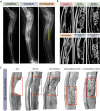Time to consider fracture nonunion an orphan disease? An update into pathophysiology, epidemiology and therapeutic solutions
- PMID: 40691747
- PMCID: PMC12279619
- DOI: 10.1007/s00068-025-02918-3
Time to consider fracture nonunion an orphan disease? An update into pathophysiology, epidemiology and therapeutic solutions
Abstract
Purpose: Fracture non-union (FNU) is a rare complication of bone fractures where healing does not occur without surgical intervention. This paper aims to summarize the current knowledge on FNUs from an orphan disease perspective, and to provide an overview of existing and some emerging treatment options.
Methods: Literature review.
Results: Epidemiological data on FNUs are limited and vary by population and methodology. While previously an overall estimate of 5-10% of nonunion of fractures has been reported, large epidemiological studies performed in Spain, Germany, Scotland and USA, reported that the prevalence of FNUs is less than 5 cases per 10.000 inhabitants justifying the criteria for an orphan designation. There are no approved pharmacological treatments for FNUs, highlighting the need for effective therapies. Current methods rely on mechanical stabilization of FNUs using various instrumentation with or without autologous bone grafting. Combining mechanical intervention and autologous bone grafting raises healing rates from 60-70% to more than 80%, but graft harvesting causes additional injury at the donor site. Lately, a novel drug, OSTEOGROW-C combining rhBMP6 with the patient's own blood coagulum as a carrier, augmented by synthetic ceramics for biomechanical support has been developed for the treatment of FNU. Results of preclinical studies suggested that OSTEOGROW-C is superior to other OSTEOGROW formulations and commercially available products.
Conclusion: Due to its low prevalence, FNU can be considered a rare disease. A novel drug, OSTEOGROW-C, represents a promising and safe therapeutic solution for inducing FNU healing.
Keywords: Autologous blood as BMP carrier; Bone graft; Fracture healing; Fracture nonunion; OSTEOGROW-C; RhBMP6.
© 2025. The Author(s).
Conflict of interest statement
Declarations. Competing interests: The authors declare no competing interests.
Figures





Similar articles
-
Clinical effectiveness and cost-effectiveness of bone morphogenetic proteins in the non-healing of fractures and spinal fusion: a systematic review.Health Technol Assess. 2007 Aug;11(30):1-150, iii-iv. doi: 10.3310/hta11300. Health Technol Assess. 2007. PMID: 17669279
-
[Volume and health outcomes: evidence from systematic reviews and from evaluation of Italian hospital data].Epidemiol Prev. 2013 Mar-Jun;37(2-3 Suppl 2):1-100. Epidemiol Prev. 2013. PMID: 23851286 Italian.
-
The Black Book of Psychotropic Dosing and Monitoring.Psychopharmacol Bull. 2024 Jul 8;54(3):8-59. Psychopharmacol Bull. 2024. PMID: 38993656 Free PMC article. Review.
-
What Is the Likelihood of Union and Frequency of Complications After Parallel Plating and Supplemental Bone Grafting for Resistant Distal Femoral Nonunions?Clin Orthop Relat Res. 2024 Feb 1;482(2):362-372. doi: 10.1097/CORR.0000000000002809. Epub 2023 Aug 28. Clin Orthop Relat Res. 2024. PMID: 37638842 Free PMC article.
-
Comparing Open and Arthroscopic Grafting for Scaphoid Nonunion: Is There Truly a Noticeable Difference?Clin Orthop Relat Res. 2024 Nov 1;482(11):2030-2038. doi: 10.1097/CORR.0000000000003145. Epub 2024 May 31. Clin Orthop Relat Res. 2024. PMID: 38843495
References
-
- Ferreira N, Marais L, Aldous C. Challenges and controversies in defining and classifying non-unions. S A Orthop J. 2014;13:52–6.
-
- Harwood PJ, Newman JB, Michael ALR. An update on fracture healing and non-union. Orthop Trauma. 2010;24:9–23.
-
- Nicholson JA, Yapp LZ, Keating JF, Simpson A. Monitoring of fracture healing. Update on current and future imaging modalities to predict union. Injury. 2021;52(Suppl 2):S29–34. - PubMed
-
- Rupp M, Biehl C, Budak M, Thormann U, Heiss C, Alt V. Diaphyseal long bone nonunions - types, aetiology, economics, and treatment recommendations. Int Orthop. 2018;42:247–58. - PubMed
Publication types
MeSH terms
Grants and funding
- GA HEALTH-F4-2011-279239/FP7 Health
- GA HEALTH-F4-2011-279239/FP7 Health
- GA HEALTH-F4-2011-279239/FP7 Health
- GA HEALTH-F4-2011-279239/FP7 Health
- GA HEALTH-F4-2011-279239/FP7 Health
- GA HEALTH-F4-2011-279239/FP7 Health
- GA HEALTH-F4-2011-279239/FP7 Health
- GA HEALTH-F4-2011-279239/FP7 Health
- GA 779340/Horizon 2020
- GA 779340/Horizon 2020
- GA 779340/Horizon 2020
- GA 779340/Horizon 2020
- GA 779340/Horizon 2020
- GA 779340/Horizon 2020
- GA 779340/Horizon 2020
- GA 779340/Horizon 2020
- GA KK.01.1.1.01.0008/European Regional Development Fund
- GA KK.01.1.1.01.0008/European Regional Development Fund
- GA KK.01.1.1.01.0008/European Regional Development Fund
- GA KK.01.1.1.01.0008/European Regional Development Fund
- GA KK.01.1.1.01.0008/European Regional Development Fund
- GA KK.01.1.1.01.0008/European Regional Development Fund
- GA 101189252/European Innovation Council and Small and Medium-sized Enterprises Executive Agency
- GA 101189252/European Innovation Council and Small and Medium-sized Enterprises Executive Agency
LinkOut - more resources
Full Text Sources
Medical

